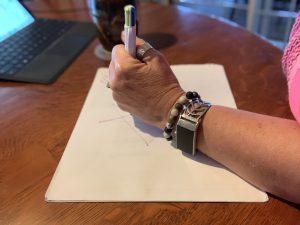In factories and offices alike, employees report more strain/sprain injuries in the dominant hand, wrist, elbow, and shoulder, because the demands on this hand are much higher than the other hand. If we could evenly distribute work demands between the left and the right hands, we’d reduce the incidence of injury. So, when I say, “Use two hands,” I don’t necessarily mean, “Use both hands together all the time.” I actually mean, “Use your non-dominant hand more often.”
Many people, especially right-handed people, think that using this tip will be really difficult – they tell us they can’t do anything with their left hand! Lefties, on the other hand (pun intended) tend to be more ambidextrous. This simple exercise will show you that you’re more adept with your non-dominant hand than you thought you were.
 Find a piece of scrap paper and two pens that are different colours. (I know, you’re thinking, where will I find pens in this day and age? You can do this on a screen if you prefer.)
Find a piece of scrap paper and two pens that are different colours. (I know, you’re thinking, where will I find pens in this day and age? You can do this on a screen if you prefer.)- Hold the pen in a power grip, in your writing hand, as shown at right.
- Draw a big star. (Or get creative
 and draw a house, or a figure 8. Nothing too fancy, please.)
and draw a house, or a figure 8. Nothing too fancy, please.) - Put the pen in your other hand and trace your drawing using the same power grip, as closely as you can.
How well did your stars align? Chances are, you surprised yourself. That’s because your non-dominant hand is nearly as good as your dominant hand, when it comes to what we call “gross motor” or “big muscle” activities. Holding the pen in a power grip forced you to use your arm to move the pen, rather than your fingers.
How can you use this new-found limb? Many ways! Try using your non-dominant hand to:
- Operate your computer mouse (no kidding – this can be life-changing! Read this for more tips on left-handed mousing.)
- Retrieve items that you plan to assemble, mix, or pack
- Hold your phone, coffee, or fork (like you were taught)
Practice makes perfect – the more you use your non-dominant hand, the easier it gets! Use this ergonomics tip yourself, and encourage your co-workers to follow suit!
Need help to spread the word? Our ergonomists can help to identify best practices for specific jobs, and can create visual aids to remind employees to use them. Contact us for help.


